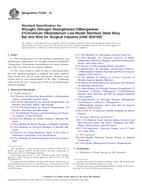Potrebujeme váš súhlas na využitie jednotlivých dát, aby sa vám okrem iného mohli ukazovať informácie týkajúce sa vašich záujmov. Súhlas udelíte kliknutím na tlačidlo „OK“.
ASTM F2212-11
Standard Guide for Characterization of Type I Collagen as Starting Material for Surgical Implants and Substrates for Tissue Engineered Medical Products (TEMPs)
Automaticky preložený názov:
Štandardné Príručka pre charakterizáciu kolagénu typu I ako východiskový materiál pre chirurgické implantáty a podklady pre prípravky tkanivového inžinierstva liečiv (brigádnikov)
NORMA vydaná dňa 1.4.2011
Informácie o norme:
Označenie normy: ASTM F2212-11
Poznámka: NEPLATNÁ
Dátum vydania normy: 1.4.2011
Kód tovaru: NS-53213
Počet strán: 13
Približná hmotnosť: 39 g (0.09 libier)
Krajina: Americká technická norma
Kategória: Technické normy ASTM
Kategórie - podobné normy:
Anotácia textu normy ASTM F2212-11 :
Keywords:
biomaterials, characterization, collagen, natural materials, TEMPs, Substrates--surgical implant applications, Surgical implants, TEMPs (tissue engineered medical products), Collagen, ICS Number Code 11.100.99 (Other standards related to laboratory medicine)
Doplňujúce informácie
| Significance and Use | ||||||||||||||||||||||||||||||||||||||||
|
The objective of this guide is to provide guidance in the characterization of Type I collagen as a starting material for surgical implants and substrates for tissue engineered medical products (TEMPs). This guide contains a listing of physical and chemical parameters that are directly related to the function of collagen. This guide can be used as an aid in the selection and characterization of the appropriate collagen starting material for the specific use. Not all tests or parameters are applicable to all uses of collagen. The collagen covered by this guide may be used in a broad range of applications, forms, or medical products, for example (but not limited to) medical devices, tissue engineered medical products (TEMPs) or cell, drug, or DNA delivery devices for implantation. The use of collagen in a practical application should be based, among other factors, on biocompatibility and physical test data. Recommendations in this guide should not be interpreted as a guarantee of clinical success in any tissue engineered medical product or drug delivery application. The following general areas should be considered when determining if the collagen supplied satisfies requirements for use in TEMPs. These are source of collagen, chemical and physical characterization and testing, and impurities profile. The following documents or other appropriate guidances from appropriate regulatory bodies relating to the production, regulation and regulatory approval of TEMPs products should be considered when determining if the collagen supplied satisfies requirements for use in TEMPs: |
||||||||||||||||||||||||||||||||||||||||
| 1. Scope | ||||||||||||||||||||||||||||||||||||||||
|
1.1 This guide for characterizing collagen-containing biomaterials is intended to provide characteristics, properties, and test methods for use by producers, manufacturers, and researchers to more clearly identify the specific collagen materials used. With greater than 20 types of collagen and the different properties of each, a single document would be cumbersome. This guide will focus on the characterization of Type I collagen, which is the most abundant collagen in mammals, especially in skin and bone. Collagen isolated from these sources may contain other types of collagen, for example, Type III and Type V. This guide does not provide specific parameters for any collagen product or mix of products or the acceptability of those products for the intended use. The collagen may be from any source, including, but not limited to, animal or cadaveric sources, human cell culture, or recombinant sources. The biological, immunological, or toxicological properties of the collagen may vary, depending on the source material. The properties of the collagen prepared from each of the above sources must be thoroughly investigated, as the changes in the collagen properties as a function of source materials is not thoroughly understood. This guide is intended to focus on purified Type I collagen as a starting material for surgical implants and substrates for tissue engineered medical products (TEMPs); some methods may not be applicable for gelatin or tissue implants. This guide may serve as a template for characterization of other types of collagen. 1.2 The biological response to collagen in soft tissue has been well documented by a history of clinical use (1, 2) and laboratory studies (3, 4, 5, 6). Biocompatibility and appropriateness of use for a specific application(s) is the responsibility of the product manufacturer. 1.3 The values stated in SI units are to be regarded as standard. No other units of measurement are included in this standard. 1.4 WarningMercury has been designated by EPA and many state agencies as a hazardous material that can cause central nervous system, kidney, and liver damage. Mercury, or its vapor, may be hazardous to health and corrosive to materials. Caution should be taken when handling mercury and mercury-containing products. See the applicable product Material Safety Data Sheet (MSDS) for details and EPA’s website (http://www.epa.gov/mercury/faq.htm) for additional information. Users should be aware that selling mercury or mercury-containing products, or both, in your state may be prohibited by state law. 1.5 The following precautionary caveat pertains only to the test method portion, Section 5, of this guide. This standard does not purport to address all of the safety concerns, if any, associated with its use. It is the responsibility of the user of this standard to establish appropriate safety and health practices and determine the applicability of regulatory requirements prior to use. |
||||||||||||||||||||||||||||||||||||||||
| 2. Referenced Documents | ||||||||||||||||||||||||||||||||||||||||
|
Podobné normy:
Historická
1.2.2009
Historická
15.4.2011
Historická
1.5.2008
Historická
15.11.2007
Historická
1.3.2014
Historická
1.10.2012



 ASTM F2181-09
ASTM F2181-09 ASTM F2182-11a
ASTM F2182-11a ASTM F2183-02(2008)..
ASTM F2183-02(2008).. ASTM F2193-02(2007)..
ASTM F2193-02(2007).. ASTM F2224-09(2014)..
ASTM F2224-09(2014).. ASTM F2229-12
ASTM F2229-12
 Cookies
Cookies
